After picking us up from the Mohammed V International Airport, Faride & Youssef drove us directly to Rabat. We spent two days in Fes. Fes, Fez, Fèz. I’ll use Fes as it was what we saw most often. It’s quite a city, c. 789 C.E. "Fes,... holds the award of being one of the oldest continuously inhabited medieval cities in the world.” “It is also considered the spiritual and cultural capital of Morocco. … The Medina of Fez is listed as a World Heritage Site and is one of the world's largest and oldest urban pedestrian zones (car-free areas). It contains the University of al-Qarawiyyin which was founded in 857 and is the oldest continuously functioning institute of higher education in the world.”

I found that as in 1978, Fes wasn’t as filled with tourists as Marrakech. As we drove from Rabat to Fez, inland, I noticed that each municipality had it’s own, beautiful lamp posts & other lighting specific to that locale. We also noticed buildings that appeared abandoned midway in construction often with wires helter-skelter. Other buildings, houses, were often at various stages of construction, with building materials laying around & no evidence of recent work. More on that later.
In general, the roads were as good as in 1978 with some new super highways.
Below is a road from 1978 I think between Tétouan & Fes. Some of the 1978 photos were scans of Kodachrome 64, Ektachrome, or Agfachrome. A few I found this morning & photographed the images projected on a screen. Some were taken by me & some by my 1978 traveling companion Richard Sobel. We carried two Minolta SRTs; one with high speed Ektachrome & one with the Kodachrome or Agfachrome 64.

This time there were cellular towers “disguised” as palm trees. I don’t think I have any photos of them.
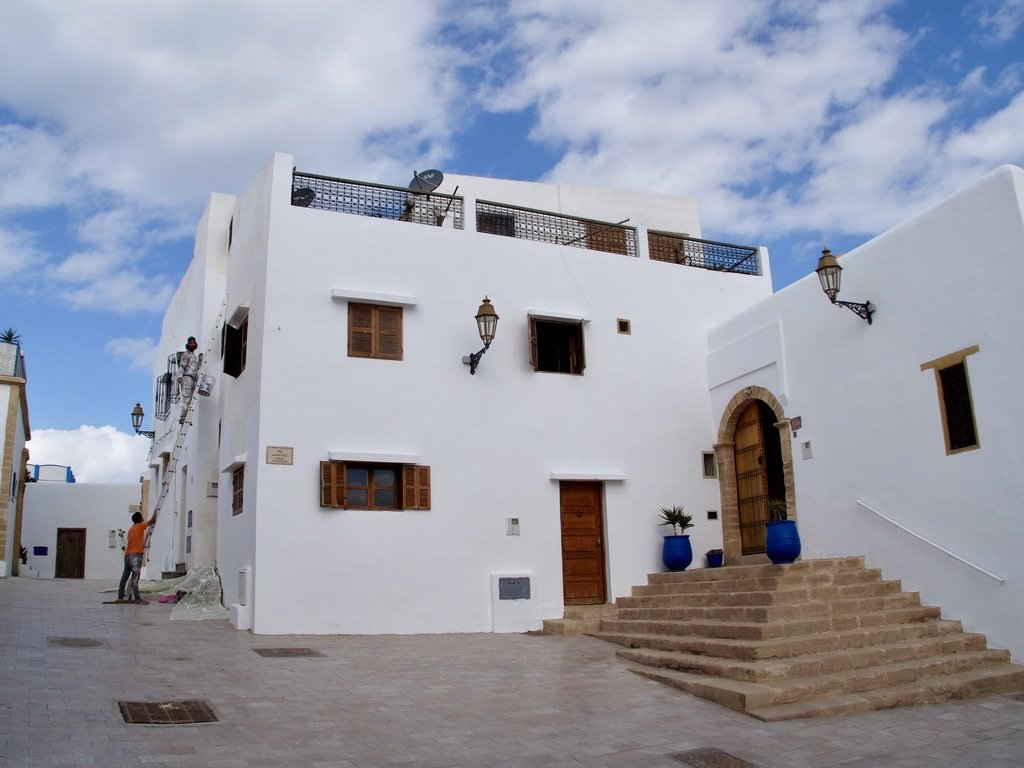
In the 17th Century Rabat Medina.

The only thing I remember from Rabat in 1978, was approaching the Atlantic shore & seeing this beached ship.

From viewpoint Oudayas a brand new lampost (recent Amazon delivery?) & in the distance the c. 1920, still operating, Fort de la Calette Lighthouse.

Youssef mentioned that once an American couple wanted to purchase this house. From its rooftop, it must have an extraordinary view of the Atlantic Ocean, the Rabat Medina, Rabat Center, the harbor & the city of Salé on the other side of the estuary Wadi Sala.

The estuary Wadi Sala of the Qued Bou Regreg (river that flows down from the Middle Atlas Mountains).

17th century Rabat Medina.

Rabat Medina.

In the lower left, the 2022 Mohammed VI Tower in Salé; the tallest building in Africa.

Always seen, men hanging out like I remembered from 1978.

Rabat, Maroc - Mausoleum of Mohammed Vi is the grand tomb of one of Morocco’s kings & his two sons. Commissioned by King Hassan II in 1962 & completed in 1971.
This fellow was motionless.

Mausoleum of Mohammed Vl.
I guess it’s about to be the changing of the guard. I never found out as a security officer appeared below signaling NO PHOTOS!!

Mausoleum of Mohammed Vl.
Positively psychedelic.

Mausoleum of Mohammed Vl.
Cute.

On the road Rabat to Fes - La Croissanterie. We got the Marin sandwich a Pepsi & a Fanta. Pepsi & Coke were about equally prevalent in Morocco.

Every little village had its own mosque paid for by donations from the people & then maintained & staffed by the Moroccan government. Note the small minaret as it’s a small village.

Road signs were often in Arabic & French & then...

...we discovered a new alphabet, Berber.

Near our Karawan Riad, in Fes.

“Karawan Riad from our room.
Riad is from the Arabic for garden. Houses centered around the riad are common in Mediterranean and Middle Eastern domestic architecture.
“During the course of our decade long restoration we’ve sourced exactly the same materials made by local craftsmen - hand-crafted zellije (glazed mosaic tiles), delicate wrought iron-work, intricate plaster and filigreed lanterns, silk embroidery and richly painted wood - and added curios and artefacts inspired by the ‘caravanserai’ that moved exquisite handicrafts, fabulous food and romantic stories all over Morocco and the Middle East.”
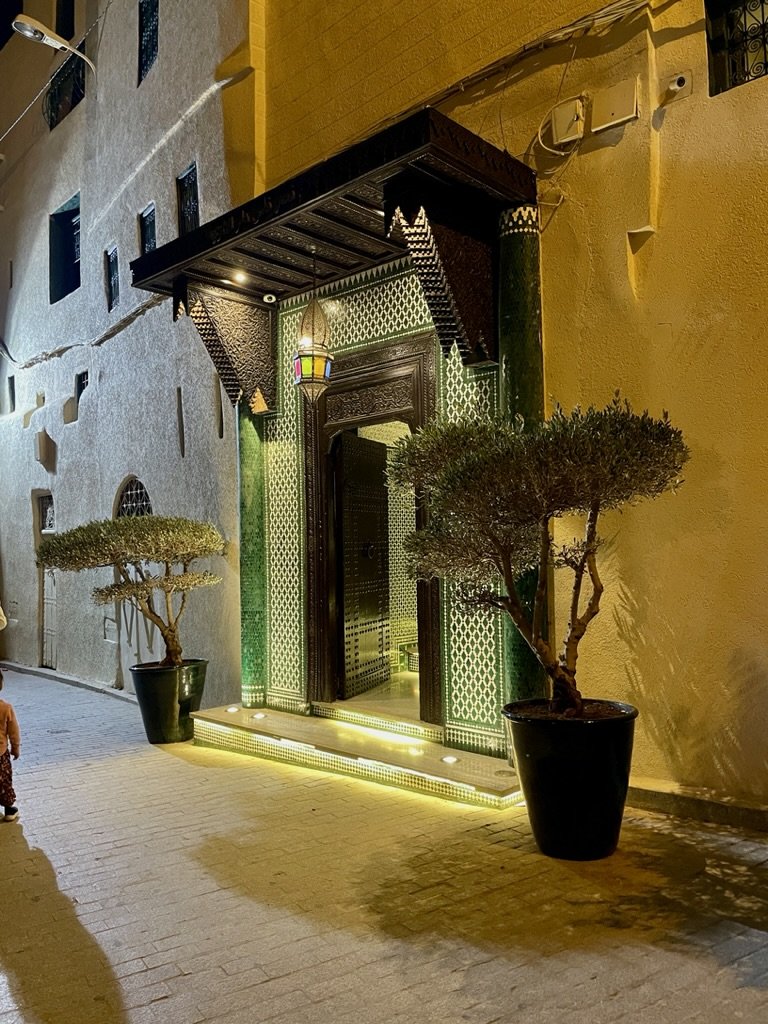
“Riad has become a common term to denote traditional Moroccan houses in general, particularly those converted into tourist accommodations.”

Fes.

-

From the rooftop of Karawan Riad. Lots of kitty cats everywhere. I didn't notice them in 1978.

Sunset From the rooftop of Karawan Riad.

Sunset from the rooftop of Karawan Riad.

The beginning of breakfast at Karawan Riad.

Near our Karawan Riad.

Near our Karawan Riad.

Near our Karawan Riad.

Fes Palais Royal (Dar El Makhzen) ‘House of the Makhzen’. It is the official Royal residence of the King of Morocco spread over 195 acres.
C. 1969-’71 doors all done by local artisans as a thank you to the king for using their services. The doors are purely decorative; they don’t work.

Fes Palais Royal.
Poem by a local poet. Note that the last letters are all the same. See if you can find Allah الله .
‘I am the door of goodness, you cover the existence of our hope. I stood in creativity, the traces of the creative twists, and my status rose above what was mentioned in the past years, and my beauty became famous, and my beauty was long-awaited, and Hassan II, the Commander of the Faithful, passed by his Lord’s state of planning and opening the port. So if the rare one commanded and came, and the rich ones came, then welcome. Enter in peace, security.’

The grand square or Mechouar was called Place des Alaouites.
Visitors had to park their vehicles at the end of the square, way behind Youssef. They then had to walk to the palace gates during which time they were inspected by guards along the way (make sure they weren’t fakers or carrying concealed weapons…) & supposedly were humbled during the long walk. Or maybe they were just trying to get their steps in.

-

-

Not the cinema but the Jewish cemetery. Closed on Shabbat. Fes is down to about 200 Jewish residents.
“Jews first began to settle in Morocco over 2,000 years ago and for centuries they and Muslims have happily co-existed there. Morocco was once home to the largest Jewish community in the Arab world and at its peak had a quarter of a million Jews.
But after Israel was founded in 1948, things changed.”
https://www.abc.net.au/news/2018-06-20/the-exodus-of-moroccan-jewish-community-to-israel/9879638

-

“Ain Nokbi, a district just outside the medina where potters were relocated in 2013 to spare their neighbours the dust and heat of the kilns.”

Ain Nokbi.
Incredibly, he & all the others were working free handed. I learned in dental school to always have a finger rest for stabilization.

Not these folks! Amazing control while spinning the wheel.

Ain Nokbi.

Ain Nokbi.
Ceramic bowls drying before any defects were corrected before a 2nd firing.
Note staircases sans bannisters.

Ain Nokbi.
He’s working metal beading into the pottery.
Most of the workers were wearing ear buds.

Ain Nokbi.

Not the first nor the last time we would see a Star of David.
Note completed large piece to the right.

Ain Nokbi.
After seeing so many mosaics over the years, I always wondered how they cut the clay tiles (zellige) to size & shape.

Ain Nokbi.
This will be a table. He’s working upside down & knows the colors of all the tiles as he places them before fiberglass is poured. Cement is no longer used. Much too heavy.

Ain Nokbi.
Another case of who needs a bannister?

Near our Karawan Riad in Fes.
The message conveyed by the sign at this water fountain is that your mother doesn’t live here, clean up after yourself.
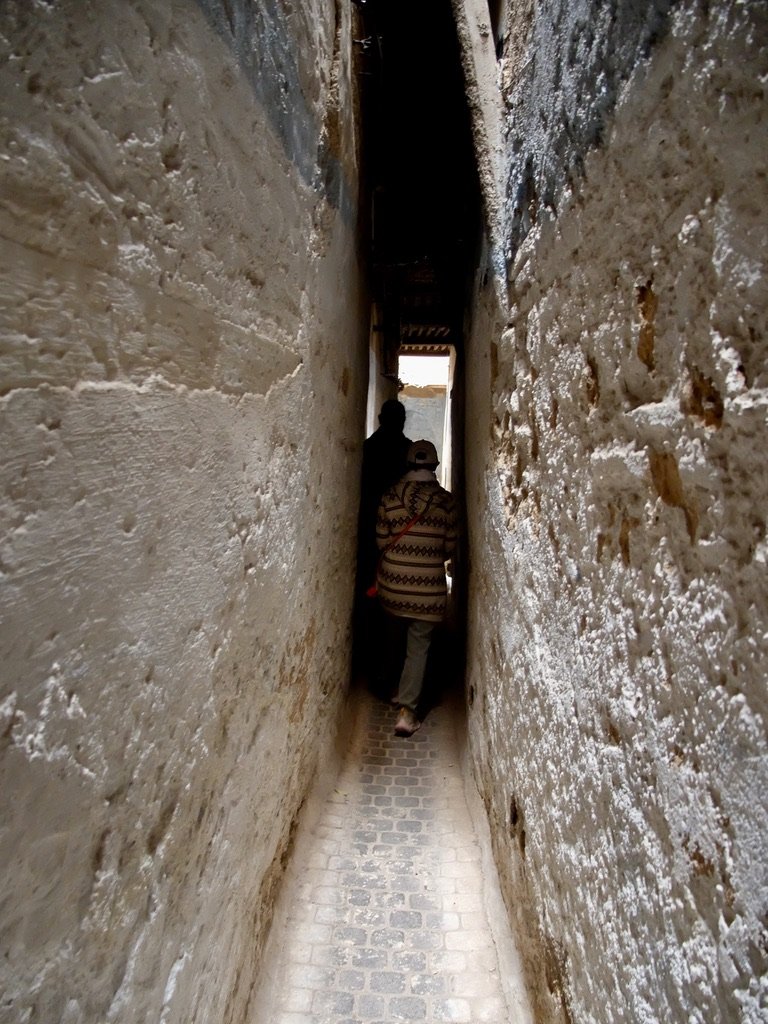
-

We saw kids playing soccer in these narrow alleys.

In 1978 Fes I was pressed up against the wall as this boy navigated past me & the donkey to deliver the bread to the communal bakery. Later in the day, I saw kids carrying the baked bread back.
I used this slide in lectures to show how children could take responsibility.

Kaab el Ghazal - Gazelle Horns (Cornes de Gazelle).
Crescent-shaped cookies that are filled with a sweet almond-orange blossom filling enclosed in a delicate pastry & molded into a crescent. Yum.

-
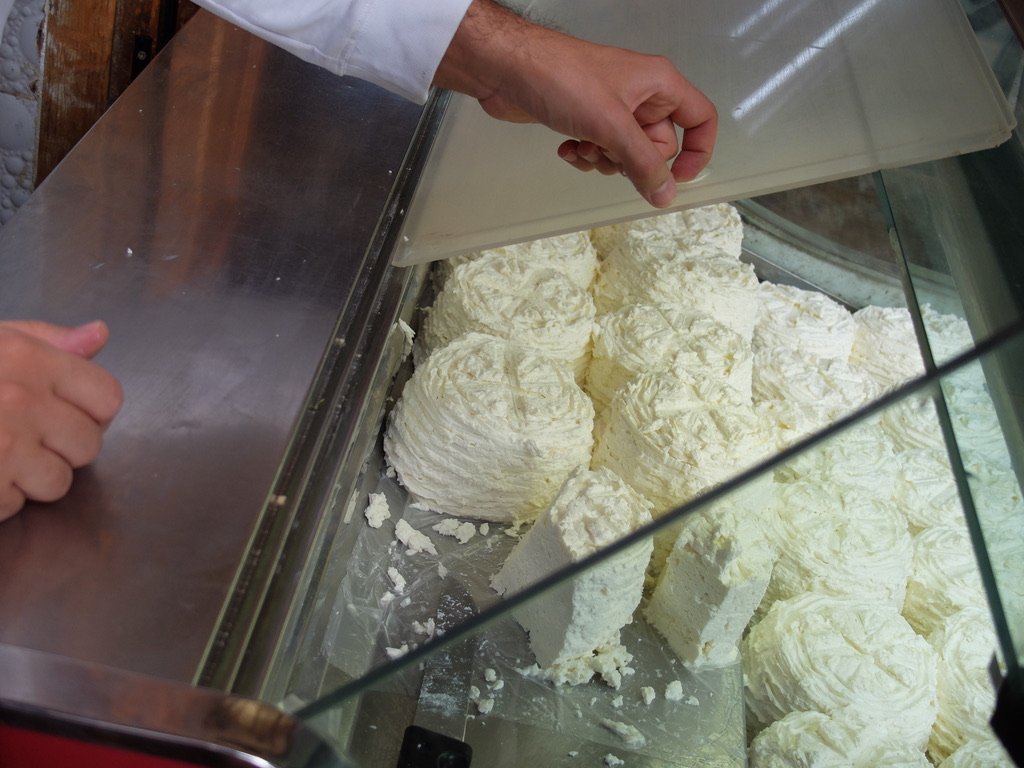
Fresh, absolutely fabulous sheep's cheese.

"I want that."

Meats are kept out on the counter to demonstrate that they are fresh.
Butchers never liked photos being taken.
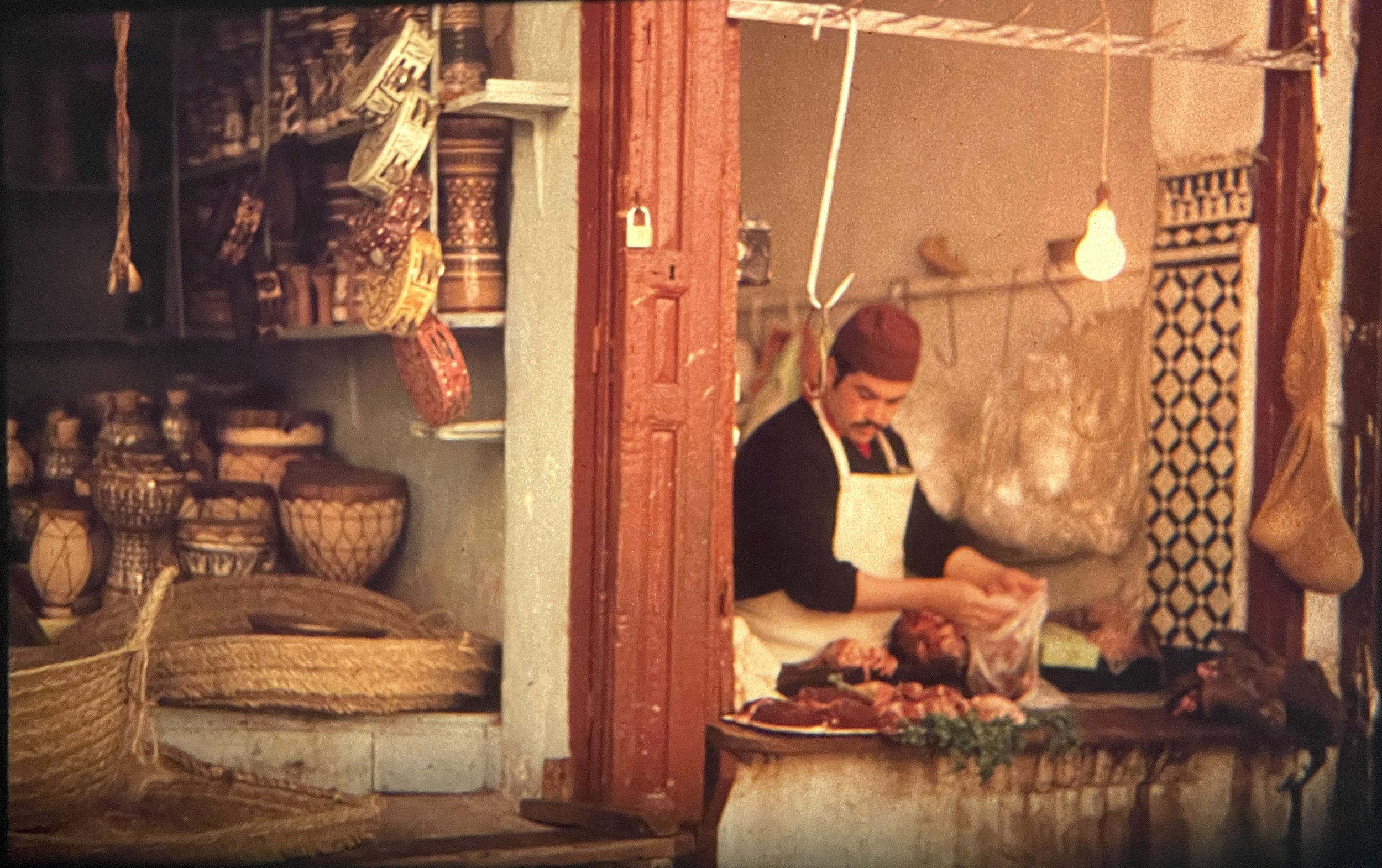
1978.

The guy with the mattresses actually said “Beep,beep!”

-

Covered in oil up to her elbows she's making a phyllo type of pastry dough.

Camel meat available here.

The souk vendors buy what they expect to sell that day.
Prices are higher in the morning when you can get your perfect choice. Later in the day, the prices come down but the buyer does not have as many choices.

The signs under the green tiled roof reads:
“Cold water
All types of dyeing
Top - wool
Silk - leather
Carpenter Idris
Dyers - Fez”

-

The area of the souk for metal goods to buy, make or have repaired.

1978.

How many men does it take...

...to repair a teapot handle?

-

-

-
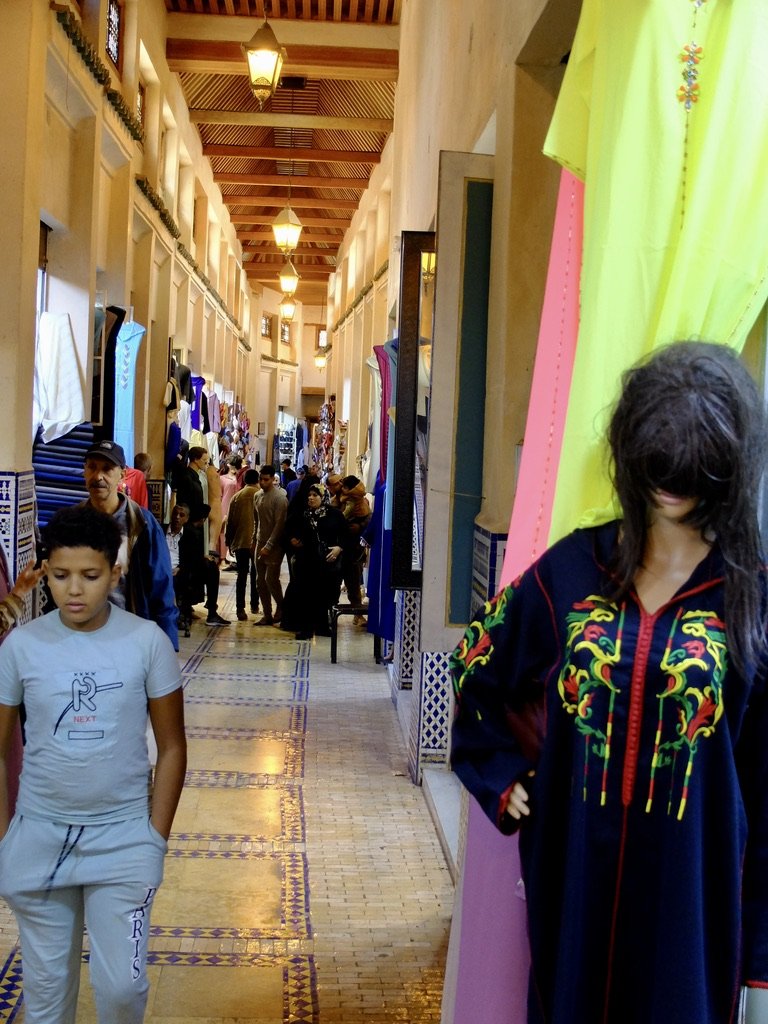
This souk has no residents above the shops. In this area, the government maintains it & collects the rents.

Not every Moroccan female wears a hijab.

And then musicians elbowed through.
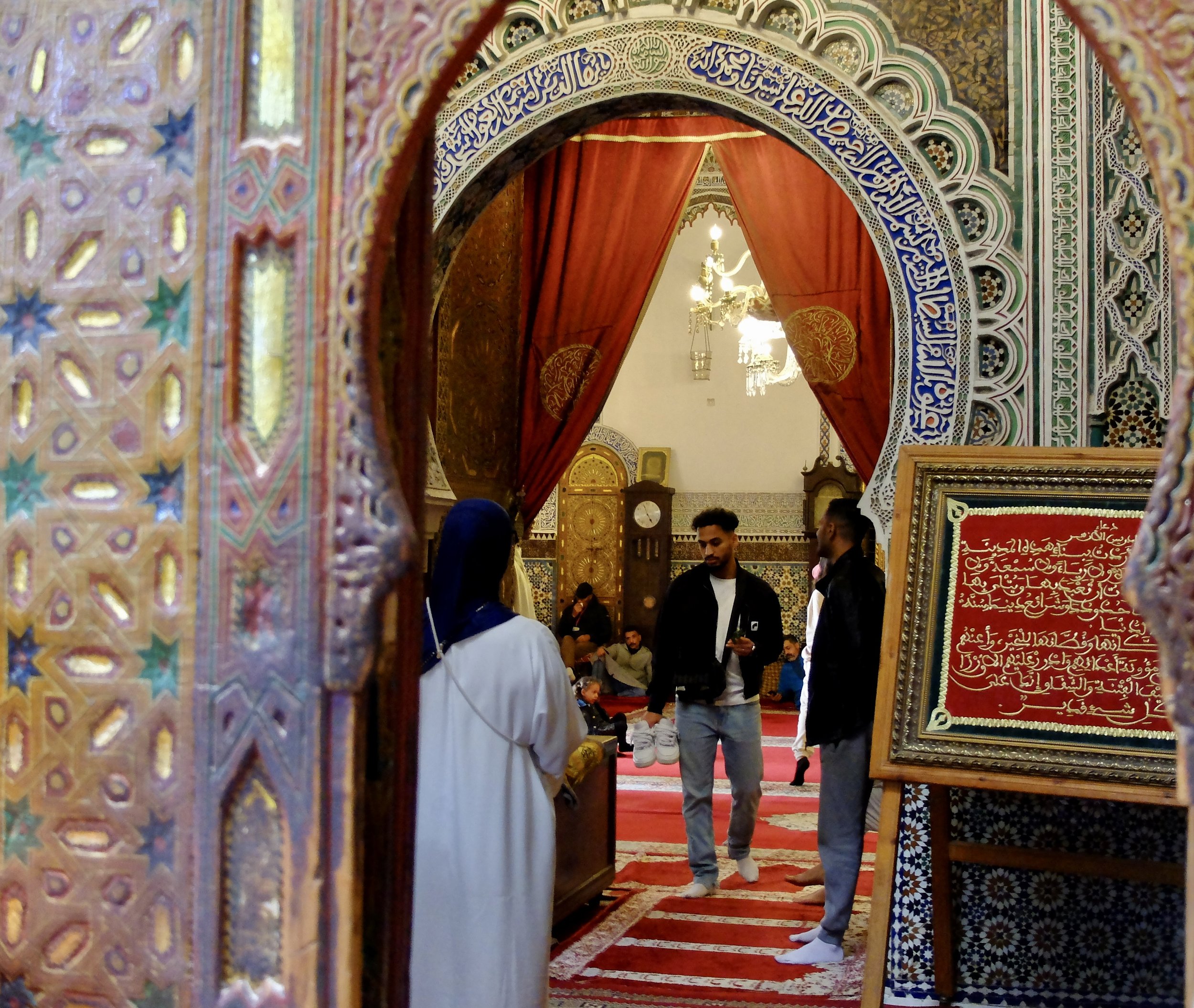
-

-

Souk of carpenters.

This craftsman creates the designs with a thin pointed tool, not a larger die.
Also note where he’s holding the hammer. I was taught to be further back to the end of the handle to have more leverage & hence more power. He’s interested in more control.

Here in 1978, he's using a larger punch.

1978 Fes.

These are some of the fellows who worked decorating the brass plates in 1978. They were happy to pose for me.

Lunch time.

-
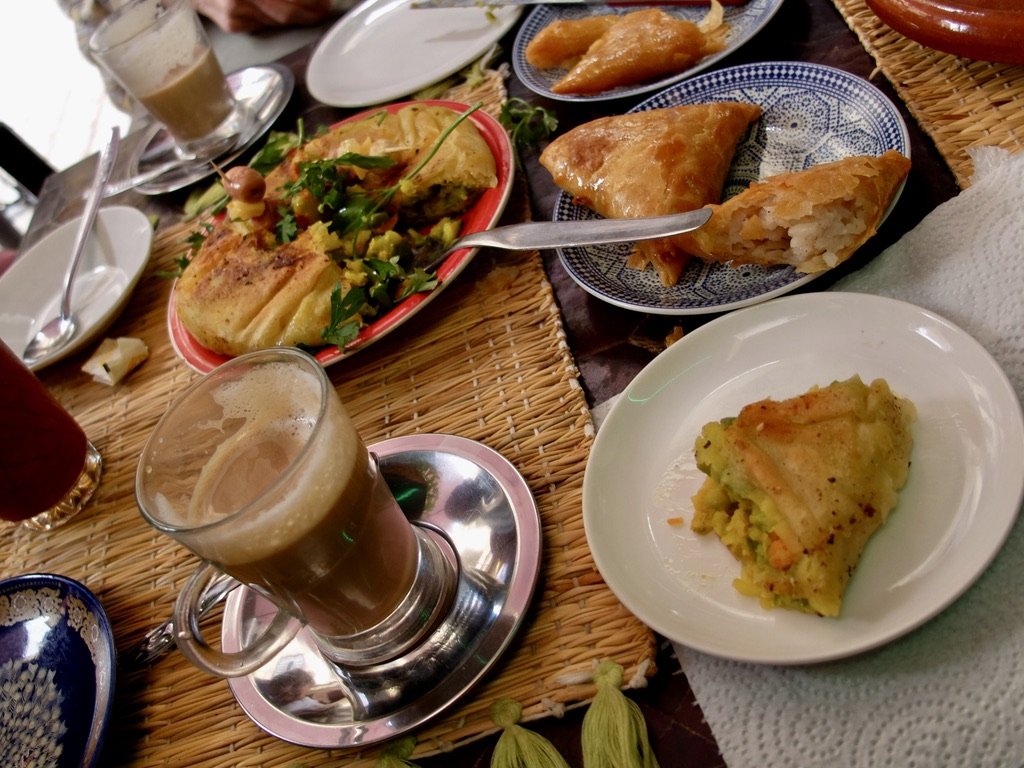
-

The donkey is called teh Moroccan Mercedes. Here, in 1978, it's not being so cooperative.

The fellow loading the donkey hid from me. I was hoping to watch him load that third sack.

-

In an area of the souk where there are no shops, there are homes of the more well-to-do.

-

-

Shop of a Jewish merchant.

Note how the alley walkway is higher than the inside of this shop. The city has gotten higher but the shop remains at the level from a looong time ago.

-

Qarawiyin Mosque, founded in 859.

A madrassa that attraacted students from all over the world.
The c. 1323-5. Al-Attarine Madrasa or Medersa al-Attarine.
We walked upstairs to visit the rooms of the students. The madrassa attracted students from all over the world.

The Chouara Tannery, the busiest, largest & oldest (over 1,000 years) tannery of the four in Fes.

Not much of a change...
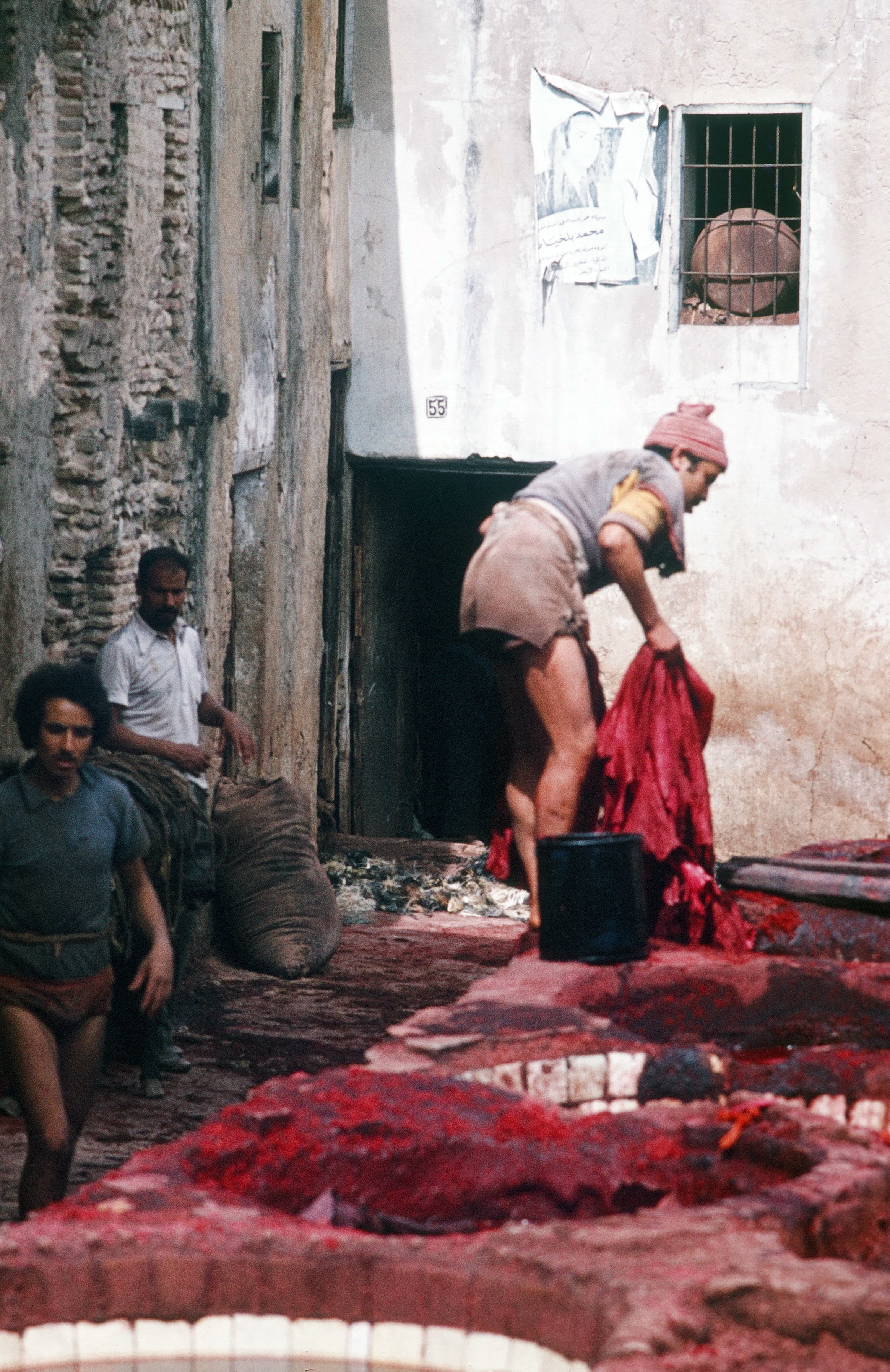
...from 1978.
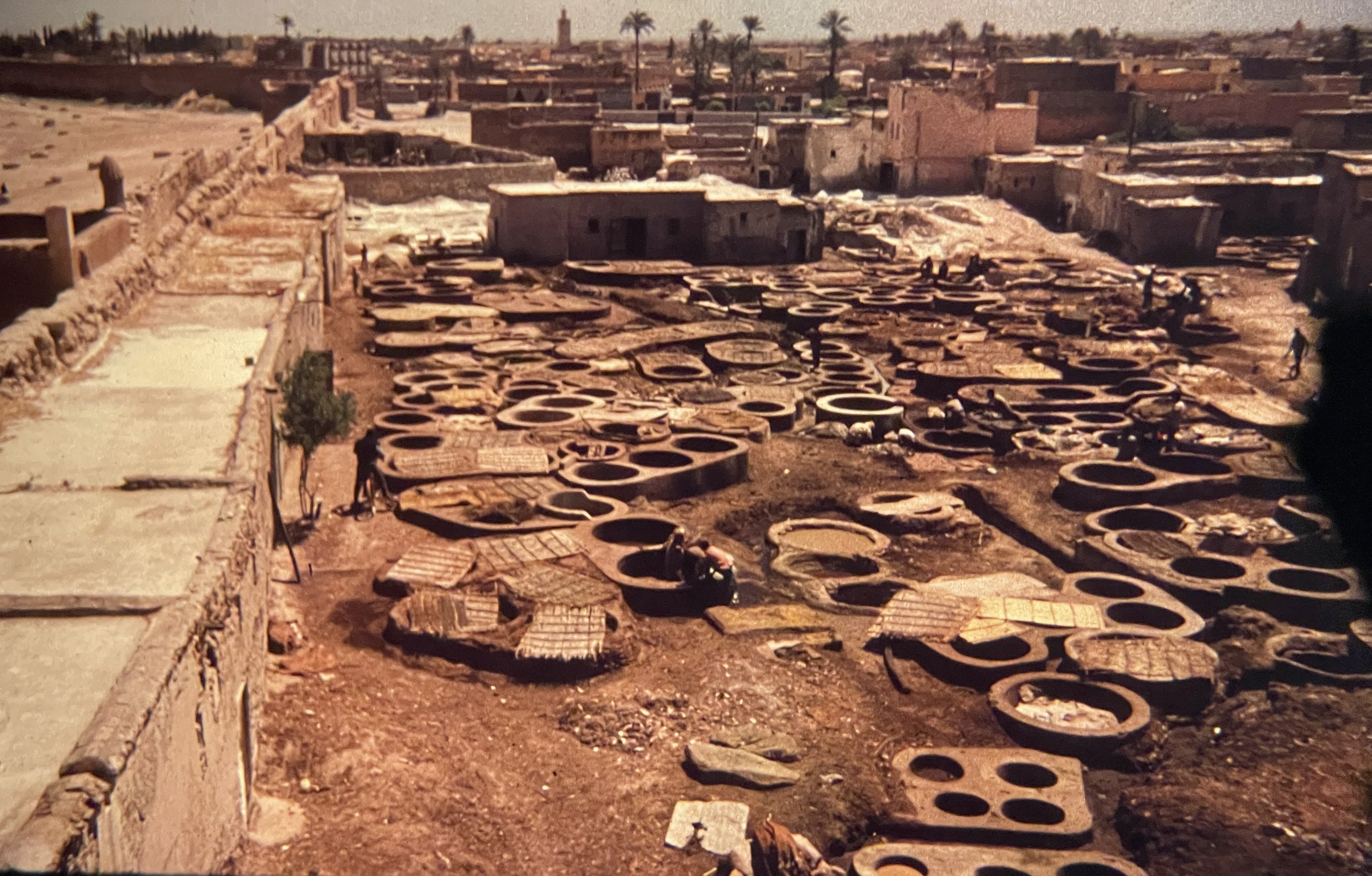
A smaller tannery in 1978. I don't remember where it was.

To leave the "Free Visit" one had to go through the shop. We did not need any leather goods.

River adjacent to the tannery.

-

I wondered what would happen when the bus arrived.

-

-

-

Note the level differences.
Goodbye Fes.
Next blog will be “The road trip to Desert Camp Merzouga with stops in Volubilis & Meknes; rainbow, rain, snow, sand storm, stops for breakfast, lunch, coffee & views & finally thru the desert in a 4 wheel drive.”